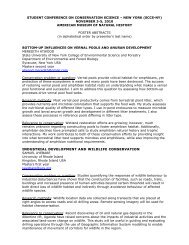EDUCATOR'S GUIDE - American Museum of Natural History
EDUCATOR'S GUIDE - American Museum of Natural History
EDUCATOR'S GUIDE - American Museum of Natural History
- No tags were found...
You also want an ePaper? Increase the reach of your titles
YUMPU automatically turns print PDFs into web optimized ePapers that Google loves.
Back in the CLASSROOM<br />
Here are questions and activities for your students to explore and to extend their understanding <strong>of</strong> the exhibtion.<br />
Grades K-4<br />
• Visit the Tree <strong>of</strong> Life Cladogram on<br />
the <strong>Museum</strong>’s OLogy website<br />
(http://ology.amnh.org/biodiversity/<br />
tree<strong>of</strong>life/). Have students explore the<br />
activity. Ask them to reflect on how<br />
scientists sort animals into different<br />
groups.<br />
• Ask your students to research a particular<br />
animal that lives in its natural environment.<br />
What physical characteristics<br />
help it survive<br />
• What did the exhibition explain about<br />
what scientists do<br />
• Ask your students how parents and<br />
children are alike and different What<br />
similarities are inherited Which are<br />
learned<br />
Darwin’s magnifying glass<br />
Grades 5-8<br />
• Visit the website Science Explorations:<br />
Zoom In on Insects (http://<br />
teacher.scholastic.com/activities/<br />
explorations/bug/). Have students<br />
explore the interactive. Ask them to<br />
reflect on how scientists classify organisms<br />
into different groups.<br />
• Based on what you saw at the exhibition,<br />
what were Darwin’s greatest<br />
contributions to natural science What<br />
questions remain<br />
• Ask students to consider why there is<br />
such an amazing diversity <strong>of</strong> species on<br />
Earth. How do species acquire many <strong>of</strong><br />
their unique characteristics<br />
• Artificial selection occurs when humans<br />
breed certain species to enhance or<br />
diminish specific traits. Can your<br />
students think <strong>of</strong> some examples How<br />
does this process mimic or differ from<br />
natural selection<br />
• What are the big unknowns in science<br />
today What might your students study<br />
if they hope to revolutionize science the<br />
way Darwin did in the 19th century<br />
• Visit the website Science Explorations:<br />
Animals, Adaptation & the Galapagos<br />
(http://teacher.scholastic.com/<br />
activities/explorations/adaptation/).<br />
Have students complete the interactives.<br />
Ask them to describe some <strong>of</strong><br />
the ways that animals adapt to their<br />
environments.<br />
Grades 9-12<br />
• Visit the Spectrum <strong>of</strong> Life interactive<br />
on the <strong>Museum</strong>’s website (http://<br />
www.amnh.org/exhibitions/hall_tour/<br />
spectrum/flash/). Have students explore<br />
the activity and reflect on how<br />
scientists classify organisms into<br />
different groups.<br />
• What do your students identify as<br />
the most compelling evidence <strong>of</strong> the<br />
predictive power <strong>of</strong> the theory <strong>of</strong><br />
natural selection<br />
• Ask students to name some practical<br />
applications <strong>of</strong> the theory <strong>of</strong> natural<br />
selection. What effect have they had<br />
on our lives<br />
• New evolutionary discoveries are<br />
being made every day. Have your<br />
students read and summarize an article<br />
on a recent discovery in evolutionary<br />
biology (e.g. a fossil find, medical<br />
development, conservation issue, or<br />
genetic research).<br />
For more specific activities to<br />
use in your classroom, visit:<br />
http://www.amnh.org/<br />
education/resources/<br />
exhibitions/darwin/educators<br />
Credits<br />
This Educator’s Guide was developed in conjunction with the Darwin exhibition and was made possible, in<br />
part, by a grant from the Carnegie Corporation <strong>of</strong> New York. The statements made and views expressed are<br />
solely the responsibility <strong>of</strong> the author. Additional support for Darwin educational programming was provided<br />
by The Dibner Fund and the Leo and Julia Forchheimer Foundation.<br />
The <strong>American</strong> <strong>Museum</strong> <strong>of</strong> <strong>Natural</strong> <strong>History</strong> gratefully acknowledges The Howard Phipps Foundation for its<br />
leadership support. Significant support for Darwin has also been provided by Chris and Sharon Davis,<br />
Bill and Leslie Miller, the Austin Hearst Foundation, Jack and Susan Rudin, and Rosalind P. Walter.<br />
Additional funding provided by Dr. Linda K. Jacobs.<br />
Darwin is organized by the <strong>American</strong> <strong>Museum</strong> <strong>of</strong> <strong>Natural</strong> <strong>History</strong>, New York (www.amnh.org), in collaboration<br />
with the <strong>Museum</strong> <strong>of</strong> Science, Boston; The Field <strong>Museum</strong>, Chicago; the Royal Ontario <strong>Museum</strong>, Toronto,<br />
Canada; and the <strong>Natural</strong> <strong>History</strong> <strong>Museum</strong>, London, England.<br />
This Educator’s Guide was produced by the Education Department at the <strong>American</strong> <strong>Museum</strong> <strong>of</strong> <strong>Natural</strong> <strong>History</strong>.<br />
Photo Credits<br />
Cover - Orchid: AMNH, C. Chesek; Darwin: Richard Millner;<br />
Blue-footed boobies: Steve Quinn Key Concepts - Tree <strong>of</strong><br />
life: Syndics <strong>of</strong> Cambridge University Library; Map <strong>of</strong> Beagle<br />
Voyage: Map by Jim McMahon. From SCHOLASTIC SCIENCE<br />
WORLD, October 3, 2005. Copyright © 2005 by Scholastic<br />
Inc. Used by permission; DNA model: AMNH, D. Finnin;<br />
Tortoise: Minden Pictures; Banner Image: AMNH, C. Chesek<br />
Teaching in the Exhibition - Young Darwin: permission<br />
<strong>of</strong> the Darwin Heirlooms Trust. © English Heritage Photo<br />
Library; Iguana: Getty Images; Darwin’s Microscope: AMNH,<br />
D. Finnin; Evolution <strong>of</strong> Horses; AMNH; Whale flipper next to<br />
human hand illustration: Elina Mer; Bacteria: Centers for<br />
Disease Control and Prevention Back in the Classroom<br />
- Magnifying Glass: AMNH, D. Finnin Inserts - Map <strong>of</strong> the<br />
Hall: Kascha Semon; Watercolor: courtesy <strong>of</strong> Richard Keynes;<br />
Beagle Model, and Darwin’s Study: AMNH, D. Finnin; All<br />
images on Connections to Other <strong>Museum</strong> Halls Insert: AMNH.<br />
(For images from the guide that are repeated on the<br />
inserts, see credits above.)<br />
© 2005 <strong>American</strong> <strong>Museum</strong> <strong>of</strong> <strong>Natural</strong> <strong>History</strong>. All Rights Reserved.

















